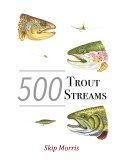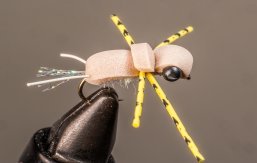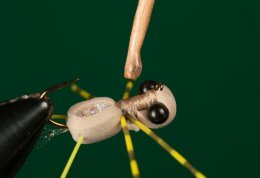Standard Indicator Nymph Fishing
Nymphing at the Pro Level
An Insider's Take on How Big-Time Nymph Fishing Works
Standard indicator nymph fishing. Among the many blessings in my life has been the opportunity to fish nymphs with guides who specialize in the art (and if it isn't art, it's definitely craft, skill, talent, technique, and some other artsy nouns) and with the authors of books on how to fish nymphs. That's provided me valuable insight into how big-time nymph fishing works—the mechanics, the rigs, the fly patterns...—plus, after a few decades at the practice, I've figured out some things on my own.
So now, I pass what I've learned along to you, thus, blessings shared. I feel good about that.
Fishing with Nymphs in Trout Rivers
Here's a good spot to mention that while there are lots of effective ways to fish a nymph in a trout lake, that's not the focus here. Here, we'll look at fishing nymphs in trout rivers.
Though I've experimented with and have spent some serious time at most of the nymph-fishing variations—including hopper-dropper and Czech nymphing and the Leisenring Lift, among others—the specific strain of nymph fishing I understand best is good old garden-variety standard indicator nymph fishing.
A Versatile Approach:
Standard Indicator Nymph Fishing
As I see it, that's a good thing—standard indicator nymph fishing is certainly the most versatile approach of them all.
With an indicator rig, the fly fisher can work his or her nymphs
- in the edge of a riffle only a couple of feet down, or
- down in a run six feet deep or even deeper,
- in water from lazy to swift,
- directly under the rod-tip to 50 feet out or further,
- with nymphs from tiny to big,
- a single fly up to three flies on the rig.
Nearly everything you can do with a nymph in a river you can pretty much do with plain old standard indicator nymph fishing.
I'm not suggesting for a moment that all the other established new and old nymph-fishing methods are inferior—on the contrary, they can be more effective than indicator fishing when conditions for them are right. I guess it all boils down to this: if I had to limit myself to one method of nymph fishing, no contest, standard indicator nymph fishing would be my clear choice. And, in fact, it's what I’ve chosen to focus on in this article.
So, you can Czech nymph to your heart's content (which happens to be, like all forms of fly fishing, good for your heart)—but you'd better bring strike indicators with you to the river and you'd better know how to use them because if that river has any real size to it at all, you'll need to use them.
When you do use strike indicators, here are some tips, tricks, strategies, and rigs to raise your own trout-river indicator-fishing to a high level. Which, of course, means more hook-ups, more trout—more fun.
When you do use strike indicators, here are some tips, tricks, strategies, and
rigs to raise your own standard indicator nymph fishing to a high level.
Which, of course, means more hook-ups,
more trout—more fun.
Loop Knots and Fluorocarbon Tippet
For years I was in a standoff with the Duncan Loop Knot. Yes, it worked, and yes, I felt it freed a fly to really come alive in the water, but no, I didn’t like the knot—I didn't like it one stinkin' bit! The problem was, and is, that the Duncan loop closes up on every fish. Sometimes it closes up, well, just to annoy me, I guess. Some fly fishers like that it closes up. You already know where I stand on the matter.
The Non-Slip Mono Loop Knot and a Few Other Choices
The standard loop knot today is the mono loop knot, also called the “non-slip mono loop knot”—non-slip, it doesn't close up! It's no cinch to tie, but how many fly fisher's knots are? It's tying is manageable. And if you don't like the mono loop knot, there are now other loop knots that also don’t close up to choose from: the Homer Rhode loop knot, the Rapala loop knot (a sort of mono loop knot with an extra step at the end), and probably a couple I've not seen. Go ahead, try one or two, pick one.
The knots I used to use for tying on my nymphs, such as the improved clinch and my own Skip's clinch, locked tippet and fly together as though they were glued. But you can't beat the way a nymph jiggles and tumbles on a loop knot—no longer is a nymph’s action in the currents limited by the flex of the tippet to which it's tied. Yay!
But you can't beat the way a nymph jiggles and tumbles on a loop knot—
no longer is a nymph’s action in the currents limited
by the flex of the tippet to which it's tied.
What About Fluorocarbon Tippet?
If you trust the opinions of a lot of sharp fly fishers who believe that fluorocarbon tippet is close to invisible in water, you can go about as heavy on tippet for your nymph fishing as you like and—thanks to that loop knot you'll now use—your nymph will still be free to shimmy in a way that pleads for a ride into a trout's mouth.
Fluorocarbon: low visibility, high price. All things considered, though, the cost of fluorocarbon tippet is probably only a fraction of what you pay for a fishing license, waders, rods, travel, lodging, and the rest for a few fishing trips.
Is fluorocarbon really almost invisible in water? You should ask the experts in the field of trout vision, light refraction, etc. and etc... I'm no expert on any of that.
The Exception to the Loop-Knot Rule
There is an exception to the loop-knot rule, and here it is: in a trailer-nymph (with a nymph streaming off a foot or more of tippet tied to the bend of the top nymph's hook) I like to use a conventional knot (improved clinch, Skip's clinch) to tie on the top nymph.
I don't expect that top nymph to do much underwater wriggling with something like a kite's tail (the trailer nymph) dragging on it, but during a cast I don't want it hinged and free to make the sort of tangles in tippet that nymph rigs like to make.
Keep Your Eyes on the Strike Indicator
Really focus on your indicator. A strike indicator can shout—that happens when a trout gives it an angry yank under water—but often, an indicator merely whispers. It stalls, a little, it twitches, a little, and the fly fisher waiting for the dramatic indicator dive misses one take of the fly after another.
...often, an indicator merely whispers.
It stalls, a little, it twitches, a little, and the fly fisher waiting for the dramatic indicator dive misses one take of the fly after another.
My friend Rick Hafele, the author of Nymph Fishing Rivers and Streams, likes to poke around in rivers while wearing a wet suit, looking like a skinny seal with a snorkel.
Once he slipped in at the tail of a run to watch the nymphs our mutual friend Dave Hughes (author of Nymphs for Streams & Stillwaters) drifted through and to see what the trout did.
- Here's what the trout did:
- Here's what Dave did:
they took Dave's nymph a lot.
he set the hook in only a few of those trout.
Rick reported all this to Dave after the event, and Dave, in disbelief, said, “No.” But, yes, that's what happened. And Dave's a sharp nymph fisher indeed—if that happened to him, just imagine how the rest of us are doing...
The point is, you have to watch your indicator so intently that you note every jiggle, every hint of drag, every nuance, and when you detect any of this—you set the hook.
The point is, you have to watch your indicator so intently that you note every jiggle, every hint of drag, every nuance, and when you detect any of this—
you set the hook.
Rick offers some fine advice to help you crank up your indicator-reading sensitivity:
strike on every drift.
That's correct—every time the indicator goes out, make a hook-set at some point during its drift. Finding a reason to react when the indicator seems to float naturally and complacently downstream means you stare at your indicator the way you'd stare at a suspicious mole when you've a family history of skin cancer.
As Rick sees it, and I agree, there's got to be something in every drift that could just possibly be labeled at least slightly suspicious. This means, of course, that you're noting every nuance, every single movement of any kind in your indicator and even every lack of movement.
Rick's exercise will fine tune your standard indicator-reading chops.
Consider the Old-Fashioned Dropper Rig
The trailer nymph rig works; I know because I've fished it plenty and have caught plenty of trout on it. But the once-popular dropper nymph rig has some advantages over it.
The trailer nymph rig hangs a second fly off the top fly by a foot or more of tippet tied to the top fly's hook bend. If a trout takes the top fly, there's not much to pad the reaction of the indicator (unless there are split shot or some other weight up the tippet). But if a trout takes the trailer nymph, the tug has to pass UP through the top nymph to send a signal up to the indicator—thus the top nymph acts as a dampener.
Actually, this all sounds worse than it really is—many trout are caught on trailer nymphs, and they're caught because the angler reads the take and sets the hook.
I'm only saying that when a trout takes the point fly of a dropper rig there's no fly in line above it to dampen the indicator's, well...indications. A dropper rig typically consists of a heavy point fly and one or two smaller, perhaps unweighted nymphs streaming off the main tippet on short lengths of secondary tippet, something like multiple flags on a single pole. Whichever nymph the trout takes, the signal to the indicator goes right up without anything between acting as a dampener.
All this indicator-sensitivity stuff aside, here's the big factor to consider with the dropper rig: the action of the dropper nymph, or nymphs. At least it's the big one for me.
All this indicator-sensitivity stuff aside, here's the big factor to consider with
the dropper rig:
the action of the dropper nymph, or nymphs.
At least it's the big one for me.
Here's why.
In perfectly clear water with good light at a good angle I've been able to really watch a dropper rig at work. I remember the first time I did so. The point fly was big and heavy, a stonefly imitation I'd chosen for the rocky, fast, stonefly sections of the anomalously swift spring creek; the dropper was a small unweighted mayfly imitation.
It was quite a show.
The big point fly glided quietly for short stretches, then bumped a stone—when it did, the little dropper nymph, streaming behind, at most a foot off the bottom, shuddered convincingly, the look of a little nymph swimming against the current.
The thought formed in my head that if I were a trout down there, there'd be no way I'd let that one get past me.
And the little dropper was pointed consistently upstream, into the current—in my experience, that's often what nymphs do as they shimmy back down to the safety of the riverbed. While it was easy for me to imagine the big stonefly moving a fish, the little dropper seemed irresistible to trout.
I used to fish the dropper system a lot, and lately I've come back around to it. The advantages I've explained; the disadvantages...well, you need to know them. The main one is serious tangles, and those tangles seem to come most often during casting. The dropper rig is a tangle in waiting.
So you must cast very smoothly, with open loops and long, graceful strokes of the rod—rush a cast or let your concentration slip for a blink and the whole lovely rig balls up in midair.
Still, that dancing little dropper nymph…that's some incentive.
Try the Downstream Strike
For most of my nymph-fishing career I simply raised my rod-tip to tighten on a trout. It was always a quick set—in indicator nymphing you must set the hook as soon as the indicator tells—but the rod-tip generally went upwards and back.
Then, some years ago, I saw video of some very savvy Czech nymph fishers and they consistently set the hook downstream. Hmmm... A trout must face upstream, so drawing the hook downstream, not forward out of but back into a trout's jaw, made perfect sense. I started swinging the rod low and downstream to set, and it seemed I hooked and landed more trout. No, I didn't conduct a study. It's just an impression. I still forget to set downstream sometimes, but I try. Old habits...
But Czech nymphing is one thing, with no strike indicator and a short line—how much angle really gets into a hook-set with a nymph three feet down and the resistance of a strike indicator above, 30 feet out from he or she who sets the hook? My guess (and that’s all it is): some. And, it would seem, enough. Enough to make a difference.
Strip to Set
You simply can't set the hook too quickly on a nymph—too hard, yes, because you want to set the hook, not yank it out—but never too quickly. If you could tug the hook home at the exact moment the indicator spoke, not a millisecond's delay, that would be the ideal.
No one will ever realize that ideal, but for the nymph fisher it's a fine goal. One move that will take you closer to that goal is to strip in a little line as you set the nymph.
This may not work for everyone, but it works for me. As I jerk the rod downstream, I yank in a bit of fly line, as though I'm making a haul on a cast. Now I've got the rod responding and the line responding too—theoretically, a response doubled in speed.
The trick is to pull the line quickly without pulling it too hard. Between jerking rod and jerking line it's easy to get a violent hook-set, which means a broken tippet or a fly simply yanked free. Getting the two under control while maintaining their speed takes practice.
So practice. The extra hook-ups are worth the effort.
Fish the Bottom, Unless You Can't
Losing nymphs is called "nymph fishing." You get that weighted fly right down among the rubble of a river bed and, sure enough, you snag up now and then. A significant percentage of those snags never let go and you break off another fly.
But considering that a bottom-bouncing nymph catches the most trout most of the time, it's a fair trade.
Sometimes, though, you really can't bang the riverbed without breaking off one fly after another—there are reasonable limits to how many nymphs you should lose per hour. I normally consider one per hour about my limit, and I'd better get some pretty good fishing in exchange.
One problem is that the nymph is simply too low. It's one thing to tick the occasional rock-top; it's another to drag the nymph along the bottom so that it snags on half its passes—the former is your goal, the latter is just ineffectual grief. You cannot catch a trout when your fly is snagged on the bottom.
Some rivers won't allow even the ticks. The rivers I fished in Michigan are a good example—every one was so constant in depth and, apparently, in flow, that wood debris littered their squared-off edges. Many of Michigan's rivers run through sandy soil, which probably explains their uncommon nature. Anyway, I tried the bottom-bumping nymph and caught a whole lot of bottom while my nymphs vanished at an alarming rate. I finally realized the trout were just going to have to come up a bit for my fly or not be caught.
There's a section of a trout river only a few hours' drive from my home where boulders about the size of large watermelons love to eat up artificial nymphs. I asked at the local fly shop about that and was told they had worked gradually up to this solution: keep your nymphs a little high. Basically, they said, don’t go down between the boulders because you'll snag them constantly; instead, set your indicator to skim your nymph over the tops of the boulders. They also said you won't reach as many fish that way, but instead of spending all your time snagged, you'll catch some fish.
Try Jig-Hook Nymphs
Turns out Czech nymphing has brought us a gift for all our nymph fishing methods: jig-hook nymphs with slotted beads. Over the past few years I've fished jig-hook flies a lot, and have caught a lot of trout on them.
I'm a fan of them primarily for two reasons:
on the riverbed and
tiny hearts out.
It's true that weighted nymphs, especially the ones tied on down-eye hooks, tend to ride upside down. But that's probably inconsistent and likely such flies do considerable tumbling in the current. (In addition to my lack of expertise on fluorocarbon underwater visibility, I'm also no authority on down-eye-nymphs-in-currents physics. Guess I'm not an expert in a lot of things.) Anyway, it's a winning bet that jig hook flies with their hook-eyes raised on stems always ride point-up. As I mentioned before, losing nymphs is part of well-executed indicator nymph fishing—but losing nymphs is certainly not the point of it. I'm sure we'd all like to keep as many flies as we can—I'm especially sure I'd like to. Jig-hook nymphs help us do that.
A loop knot, as I also mentioned, is a wonder with nymphs. They jiggle and tumble and do pretty much whatever they want to do because a loop knot leaves them free to do it. The more they move, the more lifelike and convincing to trout they become. But jig-hook nymphs? Whole new ballgame. First, the real weight on a jig-hook nymph is and should be the bead, and if that bead is tungsten the weight can be impressive; tungsten beads weigh much more than conventional metal beads .(Yeah, again, no expert on bead weight, and I looked at the packages of my standard and tungsten beads to find weights and none were given. So I'm just sticking with “weigh much more”—I can easily feel the difference.)
The idea is that with no additional weight of any consequence, beyond the slotted tungsten bead, added to the dressing of a jig-hook nymph, all the real weight is centered below the hook's eye. The fly is almost balanced in weight on either side of its hook eye. So instead of sagging to the heavy side, such a fly, swinging freely from a loop knot, can shimmy like a hula dancer rolled in itching powder. (And again, not an expert on itchy hula dancers, but just imagine...)
*****
No one seems to question that nymphs are the most reliable way to catch trout in most rivers, so improving your standard indicator nymph fishing is undoubtedly worth pursuing.
Hope I helped you in that pursuit.
Click here to hear Skip's interviews on popular podcasts...
*Announcements*
Skip has an essay in Big Sky Journal's annual Fly Fishing issue, called "Montana Hoppers: the Princess and the Brute" released February 1, 2023. Skip rewrote it a bit; I painted and illustrated it here, on our website. Here's the link on our web page to check it out:
Click here to read Skip's essay Montana Hoppers: The Princess and the Brute...
Skip's latest books:
Top 12 Dry Flies for Trout Streams: How, When, and Where to Fish Them, is now available on Amazon as an ebook...check it out! Click on the links below to go to the information page on Top 12 Dry Flies (the link to Amazon is at the bottom of the page...)
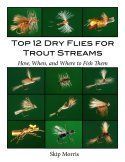 Top 12 Dry Flies for Trout Streams: How, When, and Where to Fish Them
Top 12 Dry Flies for Trout Streams: How, When, and Where to Fish Them
Click here to get more information about
Top 12 Dry Flies for Trout Streams: How, When, and Where to Fish Them (the link to Amazon is at the bottom of the page)...
Top 12 Dry Flies for Trout Streams: How, When, and Where to Fish Them (the link to Amazon is at the bottom of the page)...
Top 12 Nymphs for Trout Streams: How, When, and Where to Fish Them, 2nd Edition, originally published as an e-book only, is now available on Amazon as a paperback...check it out! Click on the links below to go to the information page on Top 12 Nymphs (the link to Amazon is at the bottom of the page...)
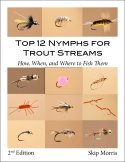 Top 12 Nymphs for Trout Streams: How, When, and Where to Fish Them (2nd Edition)
Top 12 Nymphs for Trout Streams: How, When, and Where to Fish Them (2nd Edition)
Click here to get more information about
Top 12 Nymphs for Trout Streams: How, When, and Where to Fish Them (2nd Edition). . .
Top 12 Nymphs for Trout Streams: How, When, and Where to Fish Them (2nd Edition). . .
Click here to get more information about Skip's e-book,
500 Trout Streams...
500 Trout Streams...
Skip's latest paperback book:
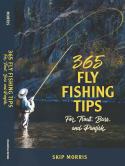 365 Fly Fishing Tips for Trout, Bass, and Panfish
365 Fly Fishing Tips for Trout, Bass, and Panfish
Click here to get more information about Skip's latest book,
365 Tips for Trout, Bass, and Panfish...
365 Tips for Trout, Bass, and Panfish...
Print Skip's chart for FREE:
Skip Morris's Trout-Fly Proportion Chart
Go to Skip Morris's Trout Fly Proportion Chart
Skip's Predator is available to buy...
Skip's ultra-popular Predator—a hit fly for bluegills and other panfishes and largemouth bass (also catches smallmouth bass and trout)—is being tied commercially by the Solitude Fly Company.
The Predator
CLICK HERE to learn more about or to purchase the Predator...
Learn to Tie Skip's Predator
Do you want to tie the Predator?
Tying the Predator
Skip shows you how to tie it on his YouTube Channel link, listed below:
CLICK HERE to see Skip's detailed video on how to tie the Predator...






